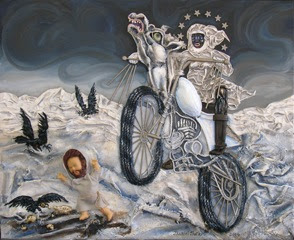"When people are ripe for a mass movement, they are usually ripe for any effective movement, and not solely for one with a particular doctrine or program." ~ Eric Hoffer
When I was really young, my brother and I used to make up games like the following, which probably a lot of kids did. For example, when we were at our grandparents house, we'd try to get all around the living room without touching the floor. The floor, we'd pretend, was molten lava or some other deadly thing. In other words, to amplify the intensity of the game, there was a heavy price to be paid if you lost. It was a life or death game and we'd really get into it.
A second game was keeping a balloon or a ball in the air, or many balloons, by tapping them upward. Gravity would bring them earthward. The stakes were high. In this game if the balloon touched the ground, the whole world would be destroyed.
These memories were triggered by a discussion between two brothers in V.S. Naipaul's Magic Seeds. The one brother's life feels empty. He has no "cause." He wishes he had something to fight for. The second brother tells him to open his eyes. "There are causes all around you."
This is the idea behind Eric Hoffer's statement above. People who feel their lives are small, who feel their lives are petty and meaningless, long for meaning. The childhood games we played as kids worked when we were kids, but as adults we know that the world will not blow up if the balloon touches the carpet.
What's especially intriguing is that both Naipaul and Hoffer seem to be saying that it hardly matters what the mass movement is. When conditions are right in peoples' hearts, there are a whole range of causes to fight, or even die, for.
Hoffer devotes a portion of his book, The True Believer, to the makeup of these people types. They are the disaffected, the poor, the misfits, the outcasts, minorities, adolescent youth, those in the grip of some vice or obsession, the bored and the sinners. They want to be free from feelings of isolation. They want to belong to something bigger than themselves. They want to give meaning to their lives. And many, if not most of us, have been in this psychological space at one time or another in our lives.
Interestingly enough, three thousand years ago King David's first army was assembled from the disenfranchised in Israel. When Saul, Israel's first king, attempted to solidify power by eliminating his potential replacement, David finally had to flee to the hills. He was joined there by others who were on the outs. In the book of Chronicles it says that, "Day after day men came to help David, until he had a great and mighty army." I used to think they followed David because he represented "right." Perhaps to some extent he was simply a galvanizing force that attracted the outcasts because many needed to belong to something. This is not to say that David was simply another mass movement, but that the Bible account corresponds with the way we'd expect people to behave based on what we know today about the sociology of mass movements.
In the world today, there are millions seeking causes, seeking meaning for their lives, and dignity. To the degree that we are unable to integrate the poor, the lower classes into society, to give them hope of a better life by contributing to the community and society at large, to this very degree they are susceptible to alternative causes. Suicide bombers don't emerge out of nowhere. They come from the disenfranchised.
This is but a starting point for a much larger discussion than there's time or space for here. Recommended reading: The True Believer: Thoughts on the Nature of Mass Movements
Meantime, life goes on all around you. Open your eyes!
This is but a starting point for a much larger discussion than there's time or space for here. Recommended reading: The True Believer: Thoughts on the Nature of Mass Movements
Meantime, life goes on all around you. Open your eyes!
























































